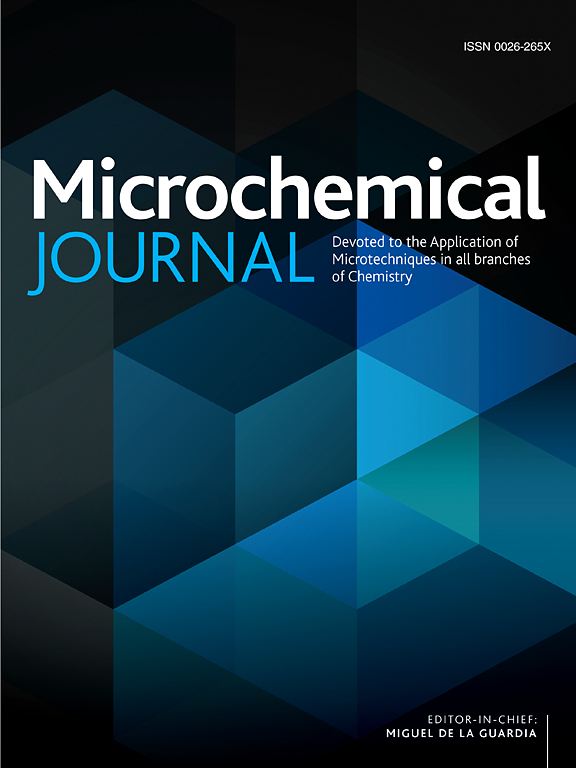固相萃取-溶液阴极辉光放电原子发射光谱法超灵敏测定高盐基质水样中的Zn、Cd、Ni、Cu和Pb
IF 4.9
2区 化学
Q1 CHEMISTRY, ANALYTICAL
引用次数: 0
摘要
本文建立了一种基于溶液阴极辉光放电原子发射光谱法(SCGD-AES) -固相萃取法(SPE)的高灵敏度测定高盐基质水样中Zn、Cd、Ni、Cu和Pb的方法。从100 mL水中收集微量金属,将pH值调整为4-10(对于大多数环境水样来说,由于其固有的pH兼容性,这一步是不必要的),使用螯合树脂(床高= 7.2 cm)的柱(id = 6.6 mm),用5 mL 1 M HNO3以3 mL/min的流速洗脱。同时,树脂柱将洗脱液的pH值从0调节到0.9(适合SCGD的酸度)。然后用恒流模式SCGD对洗脱液中的重金属进行检测。对100 mL水样进行富集处理后,Zn、Cd、Ni、Cu、Pb的检出限分别为1、0.6、2、0.6和6 μg/ L,提高了近20倍。SCGD对盐基质(以Na为例)的Cd、Cu、Ni、Pb、Zn检测耐受性可达10000 mg/L。通过对环境水样、高盐基质模拟水和标准物质(GBW08608)的成功应用,验证了该方法的准确性和实用性。本文章由计算机程序翻译,如有差异,请以英文原文为准。

Ultra-sensitive determination of Zn, Cd, Ni, Cu, and Pb in high salt matrix water samples using solid phase extraction coupled with solution cathode glow discharge atomic emission spectrometry
Herein, we developed a highly sensitive method based on solution cathode glow discharge atomic emission spectrometry (SCGD-AES) coupled with solid-phase extraction (SPE) for the determination of Zn, Cd, Ni, Cu, and Pb in high salt matrix water samples. The trace metals were collected from 100 mL water which was adjusted the pH to 4–10 (this step was unnecessary for most environmental water samples due to their inherent pH compatibility) using a column (i.d. = 6.6 mm) of a chelating resin (bed height = 7.2 cm) and eluted with 5 mL 1 M HNO3 at a flow rate of 3 mL/min. At the same time, the pH of the eluate would be adjust from 0 to 0.9 (a suitable acidity for SCGD) by the resin column. Then the heavy metals in elute were detected by SCGD with constant current mode. When 100 mL sample water was enriched, the detection limits of Zn, Cd, Ni, Cu, and Pb were 1, 0.6, 2, 0.6, and 6 μg/ L which were improved by almost 20 times. And the tolerance of SCGD for Cd, Cu, Ni, Pb, and Zn detection against the salt matrix (exemplified by Na) could reach up to 10000 mg/L. The method’s accuracy and practicality were validated through successful application to environmental water samples, high salt matrix simulated water and certified reference materials (GBW08608).
求助全文
通过发布文献求助,成功后即可免费获取论文全文。
去求助
来源期刊

Microchemical Journal
化学-分析化学
CiteScore
8.70
自引率
8.30%
发文量
1131
审稿时长
1.9 months
期刊介绍:
The Microchemical Journal is a peer reviewed journal devoted to all aspects and phases of analytical chemistry and chemical analysis. The Microchemical Journal publishes articles which are at the forefront of modern analytical chemistry and cover innovations in the techniques to the finest possible limits. This includes fundamental aspects, instrumentation, new developments, innovative and novel methods and applications including environmental and clinical field.
Traditional classical analytical methods such as spectrophotometry and titrimetry as well as established instrumentation methods such as flame and graphite furnace atomic absorption spectrometry, gas chromatography, and modified glassy or carbon electrode electrochemical methods will be considered, provided they show significant improvements and novelty compared to the established methods.
 求助内容:
求助内容: 应助结果提醒方式:
应助结果提醒方式:


